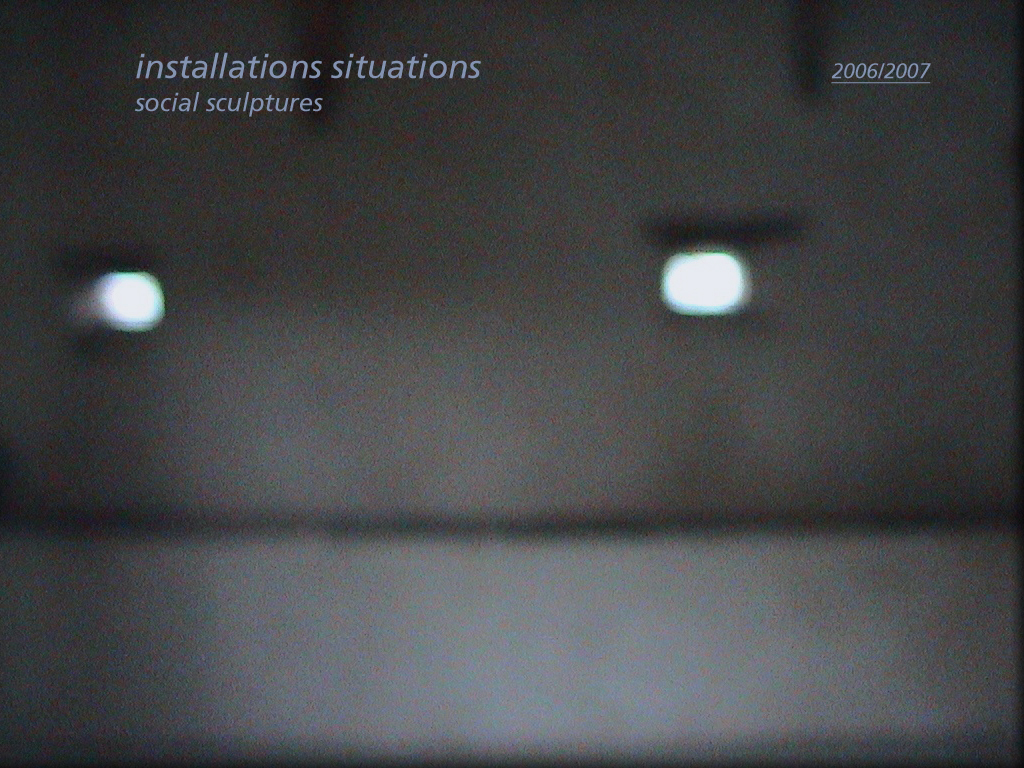
JJuul Sadée, ‘Situations’, fenster, nebelhaft, fremdkörper
©2006, 250 copies, ISBN 90-804228-3-5
(English translation below)
Fragment uit: ‘Multimediaal meten’, Joost Bolten
Maar begrijpen we altijd wat we zien of horen? Schilderijen, foto’s en multimediale installaties ervaren we meestal als dingen. Als object of voorwerp, omdat het bepaalde afmetingen heeft, omdat we het gemeten hebben aan onze waarneming. We hebben het in ons kader gezet, het tussen de coördinaten van ons begrip een plaats gegeven. Maar wat doen we als het object of voorwerp zich moeilijk of zelfs niet laat meten, vanwege zijn veranderlijke vorm of zijn beweeglijkheid? Wat kunnen we begrijpen als het bijvoorbeeld om het ‘meten’ of ‘bepalen’ zelf gaat? Dan betreft het niet enkel meer statische objecten, maar ook dynamische processen. Kunnen zulke processen zelf gemeten worden, zijn ze zelf te bepalen en te begrijpen?
In het werk van Juul Sadée spelen ramen en kaders een belangrijke rol, niet alleen in de ‘stills’ van haar tweedimensionale werk op papier en doek, maar ook in haar video’s. Ramen geven niet enkel uitzicht, ze zijn niet alleen een doorzichtige grens tussen binnen en buiten, maar ze reflecteren ook. Ze weerspiegelen, al is dat niet zo volledig als een spiegel, die een beeld volledig terugkaatst. Het virtuele vermogen van een raam is minder dan dat van een spiegel. Het uitzicht is belangrijker dan het inzicht. Maar dat geldt niet voor de video’s van Sadée. Daarin komen buiten en binnen, uitzicht en inzicht samen in het beeldscherm.
Sadée’s verhouding met het landschap staat niet los van deze functie van het raam. Het motief om de ruimte, het landschap, de werkelijkheid die ons omgeeft, te willen begrijpen en tegelijk als ongrijpbaar te erkennen, loopt als een rode draad door al haar werk.
Video is bij uitstek geschikt om (de maat van) dit begrijpen op te nemen.
We zien een vlak waarop vage rechthoekige lichtvlekken verschijnen. Bij nader inzien is het een muur van een rechthoekig interieur. Aan de linkerkant van het beeld is nog net een deursponning te zien en aan de bovenkant de overgang naar het plafond. Eerst zijn de vlekken blauw en roze, tot in het midden fel witte vlekken in de vorm van een venster verschijnen. Van buitenaf wordt het licht weerkaatst op een binnenmuur. Alsof de zon plotseling opkomt en haar licht door een venster op een muur werpt. Zo begint FENSTER. Een zonsopgang die echter een zonsondergang is en in een ver vensterruit gereflecteerd indirect op een binnenmuur wordt geprojecteerd. Ingeraamd door een monitor, begeleid door het geluid van een ritmische tik.
Fragment from: ‘Multimedia Measuring’, Joost Bolten
But do we always understand what we see or hear? Paintings, photos and multimedia installations present themselves to us first of all as things. This is because the object has certain dimensions, and because we have measured it with our perceptual criteria. We have placed it in our frame, and located it within the coordinates of our comprehension. But what do we do if the object is difficult or even impossible to measure, perhaps because of it keeps changing in form or because it keeps moving? What can we understand if, for example, it is a matter of ‘measuring’ or ‘determining’ itself? In that case we are no longer concerned only with static objects but also dynamic processes. Can such processes themselves be measured? Are they themselves susceptible to being determined and understood?
Windows and frames play an important part in the work of Juul Sadée, not only in the ‘stills’ of her two-dimensional works on paper and canvas, but also in her videos. Windows not only gives us a view outwards; a window is more than just a transparent boundary between inside and outside, for it also reflects – although not so as completely as a mirror, which throws back the image in its entirety. For a window, the outlook is more important than the view inward, the insight. But this does not apply to Sadée’s videos. Inside and outside, outlook and insight, come together on her screen.
Sadée’s attitude to the landscape is not unrelated to this function of the window. Our motivation to comprehend – while admitting the impossibility of fully grasping – space, landscape and the world around us, is a strand that runs through all her work.
Video is an excellent medium for representing, for getting the measure of, this comprehension.
We see a surface with vague, rectangular patches of light on it. On closer examination it proves to be the wall of a rectangular interior. The edge of a doorway is just visible at the left of the picture, and the border of the ceiling is evident at the top. The patches of light start off as blue and pink, but then bright, white areas in the shape of windows appear in the middle. Light from outside is being reflected onto an interior wall. It is as though the sun has suddenly risen and cast its light through a window onto the wall. This is the beginning of Fenster (Window): a sunrise which is actually a sunset, reflected from a distant window pane indirectly onto an interior wall. It is enclosed by the window of a monitor, and accompanied by a rhythmic ticking sound.